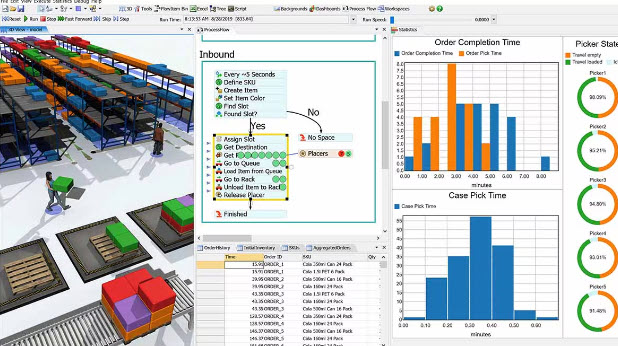& Construction

Integrated BIM tools, including Revit, AutoCAD, and Civil 3D
& Manufacturing

Professional CAD/CAM tools built on Inventor and AutoCAD
4 min read
Learn what discrete event simulation is, the benefits it provides and how Autodesk FlexSim can help.
Discrete event simulation (DES) is a powerful modeling technique used to understand, analyze, and optimize complex systems. DES simulates the operation of a system as a discrete sequence of events in time. Each event occurs at a specific point in time and marks a change of state in the system. It is widely used in many industries, including manufacturing, automotive, logistics, healthcare, and telecommunications, to improve decision-making and operational efficiency.

DES is important because it provides a dynamic and detailed representation of systems. Users are able to gain insights that are not possible through traditional analytical methods. By modeling systems as sequences of events, DES examines different components interact over time, which is crucial for understanding complex behaviors and dependencies. This level of detail can lead to more accurate predictions, better optimizations, and more informed decision-making.
Choosing the right discrete event simulation solution is crucial for maximizing the benefits of simulation. Here are some key factors to consider:
Discreate event simulation software should be user-friendly and intuitive. Users should be able to create and run simulations without extensive training. Look for solutions with a graphical interface and drag-and-drop functionality to simplify the modeling process.
Choose a solution that is flexible enough to model a wide range of systems and scalable to handle varying levels of complexity. Make sure that the software can grow with your needs and accommodate increasingly complex scenarios as your operations evolve.
Consider how well the discrete event simulation solution integrates with your existing systems and data sources. Seamless integration can streamline the modeling process and ensure that simulations are based on accurate and up-to-date information.
Comprehensive analytical and reporting tools are a must for extracting valuable insights from simulations. Choose a solution that offers comprehensive data analysis, visualization, and reporting features to help you interpret the results and communicate findings effectively.
Adequate support and a strong user community can be invaluable when adopting a new discrete event simulation solution. Ensure that the software provider offers reliable customer support, training resources, and an active user community to help you get the most out of the tool.

Autodesk FlexSim excels in providing powerful, user-friendly, and flexible discrete event simulation solutions. It offers an intuitive, drag-and-drop interface that makes it easy for users to create detailed simulations without extensive programming knowledge. Its visual nature allows users to build models by simply dragging and connecting objects, streamlining the modeling process. Designed to handle complex systems and processes, FlexSim is suitable for a wide range of industries, whether you’re modeling a manufacturing line, a hospital emergency department, or a supply chain network. It provides the tools to accurately represent and analyze your system.
FlexSim includes sophisticated analytical tools that allow users to delve deep into simulation data. With built-in reporting and visualization features, users can easily interpret results and share insights with stakeholders, facilitating data-driven decision-making. It also seamlessly integrates with other Autodesk products and a variety of data sources, enhancing its utility and ensuring that simulations are based on accurate and current data. Its flexibility allows it to adapt to different modeling needs and scale as required.
Discrete event simulation is a transformative tool that enables organizations to make informed decisions, optimize processes, and reduce risks and costs. By accurately modeling complex systems and forecasting outcomes, DES provides valuable insights that drive efficiency and innovation. When choosing a DES solution, it is essential to consider factors such as ease of use, flexibility, integration capabilities, analytical tools, and support.
By leveraging FlexSim, organizations can harness the power of simulation to improve decision-making, optimize operations, and drive success in an increasingly complex and dynamic world.
May we collect and use your data?
Learn more about the Third Party Services we use and our Privacy Statement.May we collect and use your data to tailor your experience?
Explore the benefits of a customized experience by managing your privacy settings for this site or visit our Privacy Statement to learn more about your options.